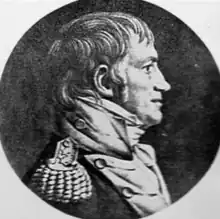John Smith (naval officer)
Captain John Smith was a United States Navy officer, who served during the First Barbary War and later in the War of 1812. He commanded USS Vixen, USS Syren, USS Wasp, USS Essex, USS Congress, and USS Franklin.
John Smith | |
|---|---|
 Captain John Smith, United States Navy | |
| Born | January 1, 1780 England |
| Died | August 6, 1815 Philadelphia, Pennsylvania, US |
| Place of burial | St. Peter's Church Yard in Philadelphia |
| Allegiance | |
| Service/ | |
| Years of service | 1799–1815 |
| Rank | Captain |
| Commands held | |
| Battles/wars | |
Early life
He was born in England on 1 or 2[1] January 1780 as the eldest son of Rev. William Smith (not related to another Rev. William Smith). John Smith was brought by his parents to Charleston, South Carolina, at age 4, sometimes in December 1785.[2]
Military service
At age 19, on 28 February 1799, he was appointed as a lieutenant in U.S. Navy. His commission was accepted on 19 June 1799. His first assignment was on board of USS Chesapeake, beginning 12 February 1800. On 27 April he sailed on USS Chesapeake for the Mediterranean Station, and cruised off Tripoli, returning to the Washington Navy Yard on 1 June 1803 to oversee the building of USS Vixen at Baltimore, which he commanded during the First Barbary War.
First Barbary War
In August 1803, then-Lieutenant Smith took USS Vixen from Baltimore to Gibraltar, where on 14 September 1803 he joined the Mediterranean squadron of Commodore Edward Preble. From there until the end of year he was patrolling Tripolitan waters in company of USS Philadelphia, until the latter was captured. Lieutenant Smith continued cruising the Mediterranean seas and off the Barbary States during the first half of 1804. He re-joined the squadron of Commodore Rodgers in Malta in May 1804.
.jpg.webp)
Smith was promoted to Master Commandant on 18 May 1804. He took command of USS Syren[3] on 3 July 1805 and after a peace treaty with Tripoli was signed on 10 June 1805, he remained in the Mediterranean for almost a year helping to establish and maintain satisfactory relations with other Barbary states. He took USS Syren back to the United States on 28 May 1806 and soon after was assigned at Washington to supervise the fitting out of USS Wasp. As her commander Smith was heavily involved in supporting Jefferson's Embargo. He delivered an army garrison from New York City to Passamaquoddy in June 1808, patrolled Casco Bay, Maine, in the winter of 1808–1809, and remained at Portland until May, 1809.
During his next assignment he commanded the famous USS Essex, lasting until his promotion to Captain on 29 October 1810.
War of 1812
His next assignment was to USS Congress. He assumed command of her on 11 July 1811. Upon the declaration of the War of 1812 USS Congress joined the squadron of Commodore John Rodgers, and distinguished herself by capturing five British vessels as recorded by Louis F. Middlebrook in Vol. LXIII, October 1927 of Essex Institute Historical Collections:[4]
November 1, 1812, off Western Islands, the British merchant ship Argo, 10 guns and 26 men, with a cargo of oil and whalebone, bound for London, and ordered to the United States.
May 19, 1813, in Lat. 28 N., Long. 42 W., the British brig Jean, 10 guns and 17 men, with a cargo of copper, hides, etc., bound to Greenock. After taking out the copper, the brig was burned.
May 22, 1813, in Lat. 24 N., Long. 40 W., the British brig Diana, 10 guns and 14 men, with a cargo of copper and hides bound to London, and sent into Barbadoes with the prisoners, after throwing overboard her cargo.
October 25, 1813, in Lat. 19 N., Long. 40 W., the British ship Rose, of 182 tons, crew of 12 men, with a cargo of wine and potatoes. Burned. All of her crew voluntarily enlisted in the service of the United States.
December 5, 1813, in the North Atlantic, the British brig Atlantic, crew of 12 men and a cargo of sugar and cotton from the West Indies to Cork. This brig was sent into Boston.
At the end of the war, Captain Smith was transferred to command USS Franklin, but died before or right around her launch in August 1815.
Death
Captain John Smith was buried to rest in peace in St. Peter's Church Yard in Philadelphia.
The inscription on his stone, which didn't survive, read:[5] "Sacred to the memory of JOHN SMITH ESQR. a native of South Carolina, late Post Captain in the Navy of the United States, and commander of the FRANKLIN, of 74 guns, who departed this life at Philadelphia, on the 6th day of August, 1815, Aged 35 years and 7 months, Universally lamented by all who had the happiness of knowing him. This tribute of respect for his many virtues was erected by his Affectionate Brother-in-law, Samuel Patterson, of South Carolina."
References
- United States. Office of Naval Records and Library. (1939–42). Naval documents related to the United States wars with the Barbary powers. U.S. Govt. Print. Office. p. 249. OCLC 221027988.
- Loomis, Hezekiah (1928). Journal of Hezekiah Loomis, steward on the U.S. Brig "Vixen", Captain John Smith, U.S.N.; war with Tripoli, 1804. Essex Institute. OCLC 3678627.
- Frost, John (1845). Pictorial book of the commodores : comprising lives of distinguished commanders in the navy of the United States. Hardpress Publishing. p. 295. ISBN 978-1290318860. OCLC 940525118.
- Middlebrook, Louis F. (1927). Essex Institute historical collections. Essex Institute. pp. Vol. LXIII. OCLC 6140167.
- William W. Bronson, The Inscriptions in St. Peter's Church Yard, Philadelphia, printed at Camden, N. J., p.355, 1879